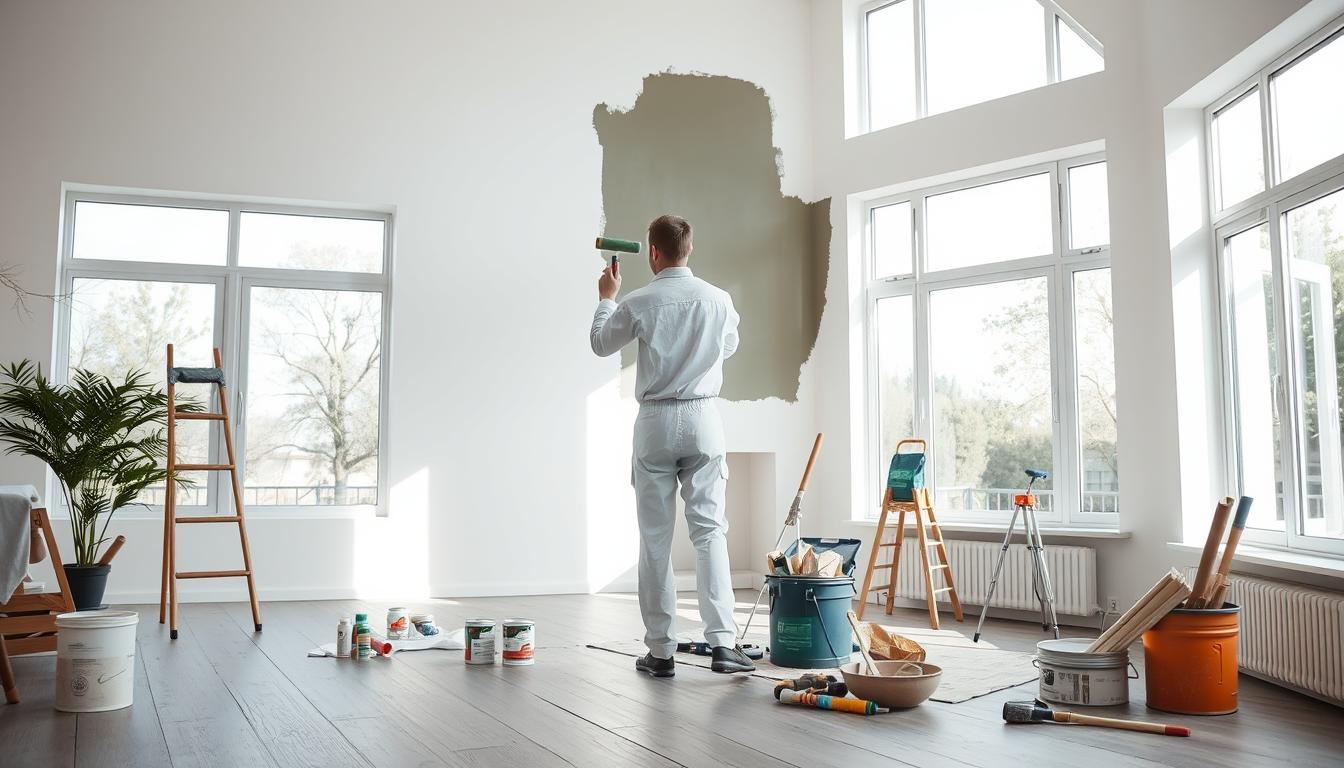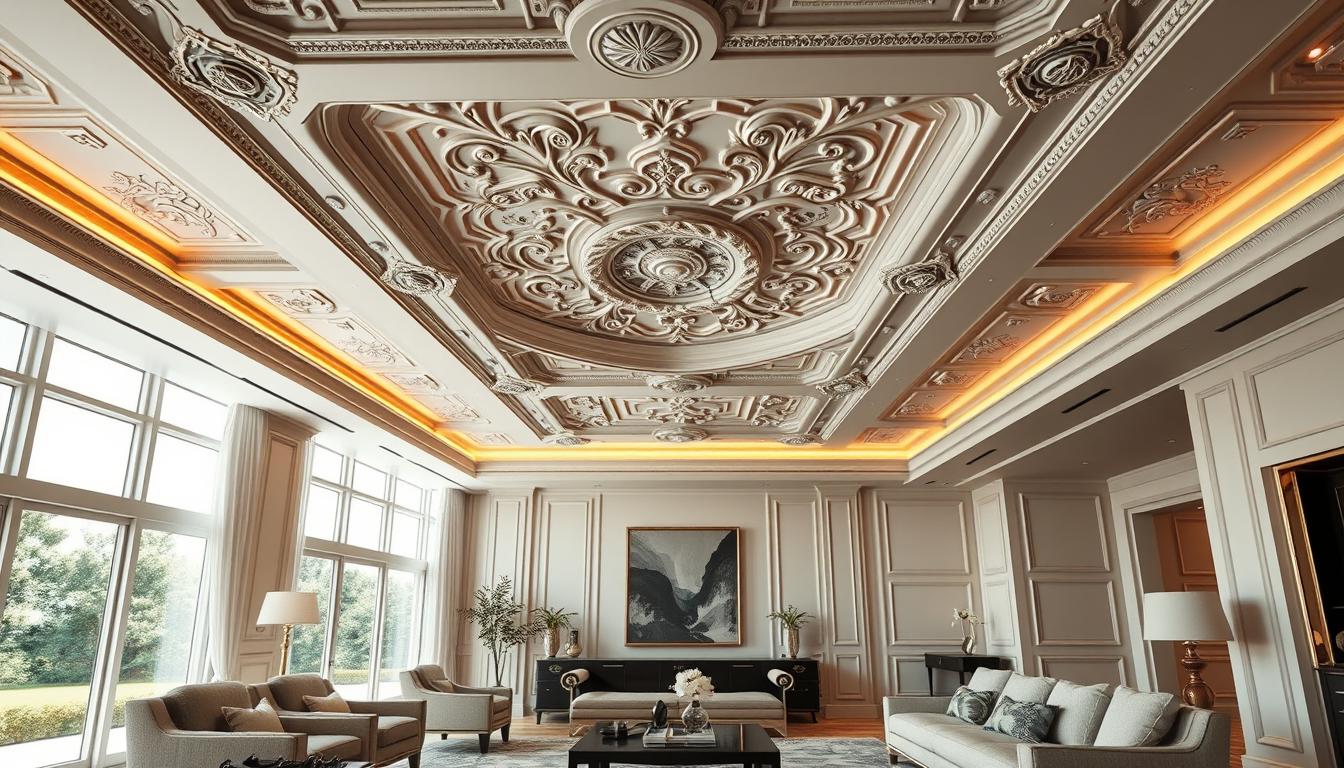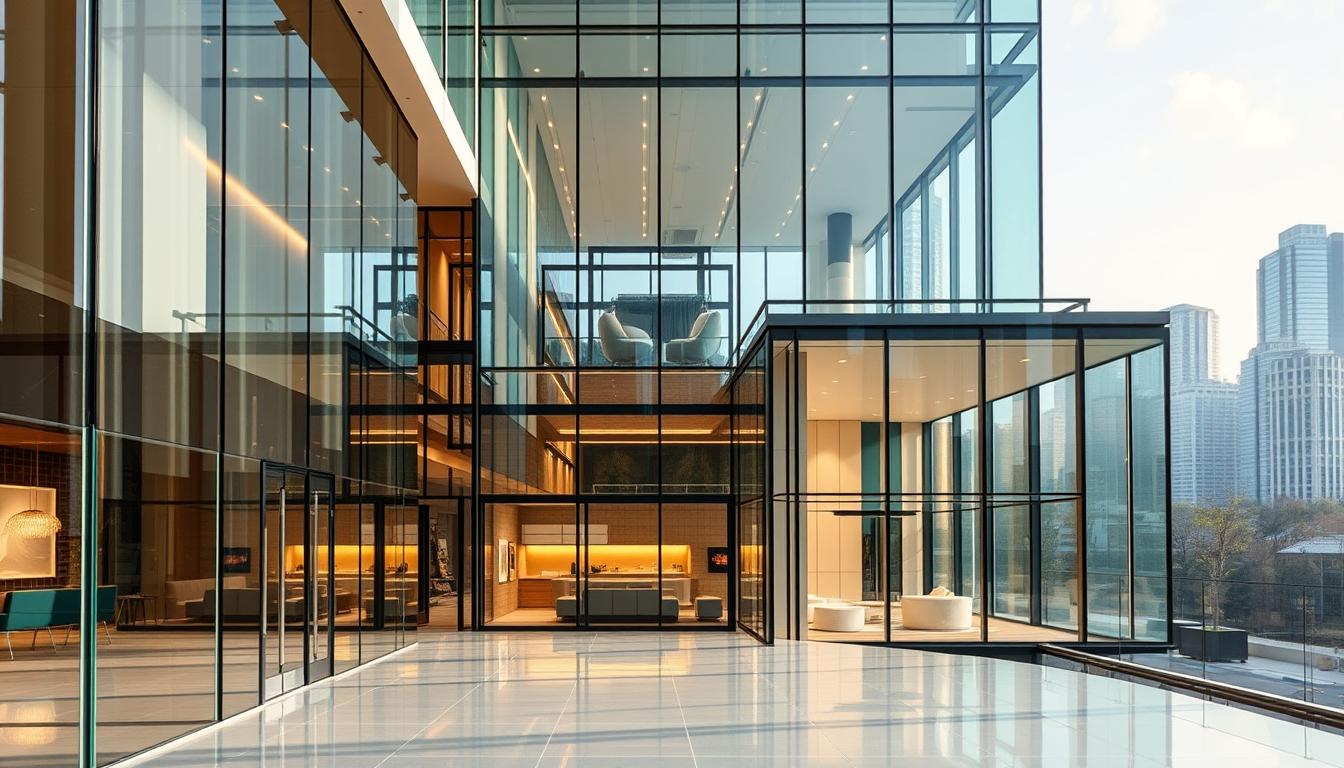Painting your home’s interior can be a big job. The cost can change a lot based on different things. For example, painting a 2,000 sq. ft. house might cost between $7,500 and $19,800.
Several factors influence the final cost. These include the size of your home, how many rooms it has, and the paint quality. Knowing these can help you plan your budget for painting your home.
Key Takeaways
- The average cost to paint a 2,000 sq. ft. house ranges from $7,500 to $19,800.
- Home size, number of rooms, and paint quality are key factors affecting the cost.
- Proper planning and budgeting are essential for a successful interior painting project.
Understanding the Basics of Painting Costs
To understand the cost of painting a room, we need to look at what affects it. The price can change a lot based on different things.
Average Cost per Square Foot
The cost to paint a room can be between $3 and $7 per square foot. This depends on how hard the job is and the paint quality. For a typical house, this means spending $1,500 to $4,900 or more.
- Low-end estimates: $1 to $3 per square foot for basic paint jobs.
- Mid-range estimates: $2 to $4 per square foot for standard quality paint.
- High-end estimates: $4 to $7 per square foot for premium paint and detailed work.
Factors Influencing the Cost
Many things can change how much it costs to paint a house’s inside. These include:
- Size of the home: Bigger homes need more paint and work.
- Number of rooms: More rooms mean more to paint.
- Prep work required: Cleaning, fixing, and priming can increase the cost.
- Ceiling height: Higher ceilings need more work and might need special tools.
Cost Variations by Paint Type
The paint you choose greatly affects the cost. Here’s a comparison:
| Paint Type | Cost per Gallon | Coverage per Gallon |
|---|---|---|
| Budget-friendly | $20-$30 | 350-400 sq ft |
| Mid-range | $30-$50 | 400-450 sq ft |
| Premium | $50-$70 | 450-500 sq ft |
Choosing paint is about finding the right balance between cost, quality, and finish.
Assessing Your Home’s Interior
To figure out the interior house painting cost, you need to check your home’s interior well.
When assessing your home, look at several important factors. These include your home’s square footage, where the rooms are, and any special architectural details.
Evaluating the Square Footage
The size of your home, in square feet, is key to figuring out the average cost to paint a room. Bigger homes need more paint and work, which raises the price. To get a precise estimate, measure each wall’s length and height. Then, add up the total square footage.
https://www.youtube.com/watch?v=LB8BZL02-N0
Location of Rooms Impacting Cost
The spot of rooms in your home can also change the professional interior painting cost. Rooms that are tough to get to or need special tools, like high ceilings or fancy trim, cost more. For example, painting a room with a high ceiling might need extra gear and time, making it pricier.
Architectural Features to Consider
Special architectural details, like big windows, complex molding, or many levels, make painting harder. These details need more time and special skills, which can up the price. It’s key to spot these features when you assess your home to get a correct quote.
For a detailed cost breakdown, talking to a pro is a good idea. You can learn more about painting a house’s interior on Mr. Handyman’s blog.
| Feature | Impact on Cost | Example |
|---|---|---|
| Square Footage | Increases with larger areas | A 2,000 sq. ft. home costs more to paint than a 1,000 sq. ft. home |
| Room Location | Higher costs for harder-to-reach areas | Rooms with high ceilings or complex access |
| Architectural Features | Complex features increase labor | Intricate trim work, large windows, or multiple levels |
Choosing the Right Paint
The type of paint you choose can greatly affect your interior painting project’s cost. There are many options, and knowing the differences is key. This helps you make a choice that fits your budget.
Budget Paint vs. Premium Paint
When painting your house’s interior, the choice between budget and premium paint matters. Budget paints start at $20 per gallon, making them affordable for big areas. Premium paints, costing over $100 per gallon, offer better quality and durability. This Old House notes that paint choice significantly impacts the interior wall painting cost.
Premium paints are pricier but last longer. They cover better, resist fading and chipping, and need fewer coats. This saves time and money in the long run.
Eco-Friendly Paint Options
Eco-friendly paints are popular for their low VOC emissions, making them healthier for indoor painting. They come in both budget and premium options. Some eco-friendly paints are priced like premium ones but offer environmental benefits.
When picking eco-friendly paints, look for certifications like Greenguard Gold or CARB compliance. These ensure they meet high indoor air quality standards.
Different Finishes and Their Prices
The paint finish also affects home interior painting prices. Finishes range from flat (matte) to high-gloss, each with its own price and use.
- Flat finishes are cheaper and good for low-traffic areas.
- Satin and semi-gloss finishes are durable and easy to clean. They’re best for kitchens and bathrooms but cost more.
Knowing the pros and cons of each finish and their prices is crucial. It helps you get the look and durability you want within your budget.
By thinking about paint type, quality, and finish, homeowners can make smart choices. These choices balance looks and budget, affecting the cost of painting a house interior.
DIY vs. Hiring Professionals
Choosing whether to paint your home yourself or hire pros is a big decision. Both paths have their pluses and minuses, which we’ll dive into.
Pros and Cons of DIY Painting
DIY painting can save you money on labor. It’s a cost-effective way to refresh your home. But, it takes a lot of time and effort. The quality of your work depends on your skills.
- Pros:
- Save on labor costs
- Feel proud of doing it yourself
- Work at your own pace
- Cons:
- It takes a lot of time and effort
- Quality might not be as good
- You’ll need to buy or rent tools and supplies
Cost Breakdown for Professional Services
Professionals can give you a top-notch finish and might save you money in the long run. Their rates vary from $40 to $100+ per hour, based on location and skill. An interior painting cost estimator can give you a better idea of what to expect.
| Service | Cost Range | Average Cost |
|---|---|---|
| Hourly Rate | $40 – $100+ | $70 |
| Per Square Foot | $2 – $6 | $4 |
| Whole House (Average 2,000 sq ft) | $4,000 – $12,000 | $8,000 |
When to Consider Hiring Professionals
If you’re tight on time, not experienced, or have a complex project, think about hiring pros. They can manage tricky parts, ensure a smooth finish, and avoid mistakes. The professional interior painting cost might seem steep at first, but it can save you money by avoiding frequent touch-ups.
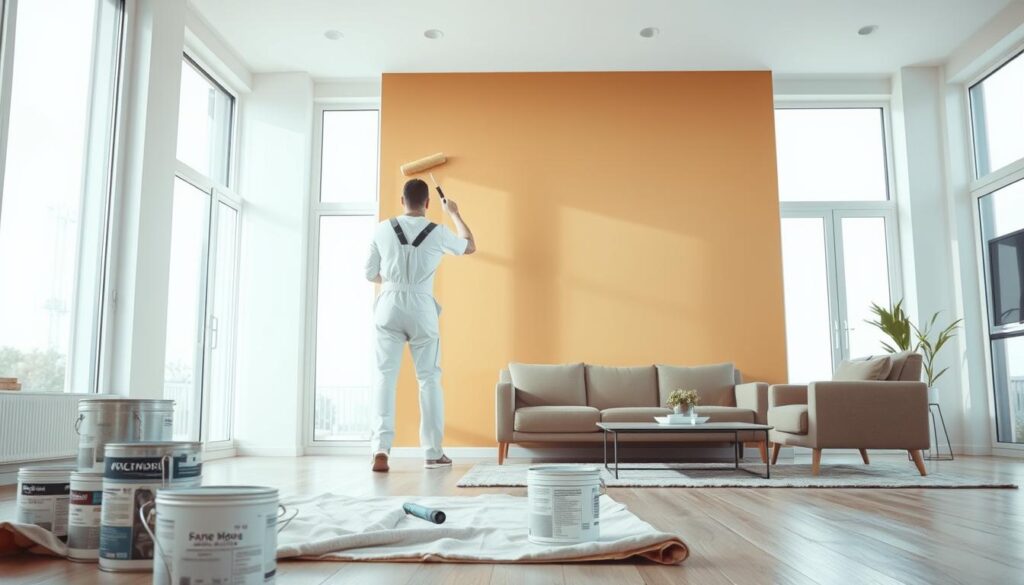
Painting Preparation Costs
Before you start painting, it’s key to know the prep costs. Getting your home ready for paint is a big step that affects your total cost. It takes time, effort, and extra money to do it right.
Cleaning and Repairing Surfaces
Cleaning and fixing surfaces is a must. This means fixing holes, sanding rough spots, and cleaning off dirt and grease. The cost depends on how much work is needed.
If your walls have old paint or damage, you might need pros. This adds to your interior house painting cost.
Primer Application Needs
Primer is a key step before painting. It helps paint stick better, covers stains, and might cut down on coats. The type and quality of primer you pick can change your cost to paint the interior of a home.
Some surfaces, like wood or drywall, need special primers. Others might need stain-blockers. Knowing what you need helps with your budget.
Furniture and Fixture Protection
Protecting your furniture and fixtures is also important. This means covering floors, moving furniture, and masking trim. The cost depends on your space size and how much you have to protect.
| Service | Average Cost | Description |
|---|---|---|
| Surface Cleaning | $100-$300 | Cleaning walls to remove dirt and grime |
| Repairing Holes/Cracks | $200-$500 | Fixing damaged walls |
| Primer Application | $150-$400 | Applying primer to surfaces |
| Furniture Protection | $100-$300 | Covering floors and furniture |
In conclusion, prep costs are a big part of the cost to paint the interior of a home. Knowing the costs for cleaning, fixing, primer, and protecting furniture helps you plan your budget for home interior painting prices.
Regional Cost Differences
It’s important to know how costs change by region when painting the inside of a house. The price can go up or down a lot, depending on where you are. Cities usually cost more than countryside areas.
Average Cost in Urban vs. Rural Areas
There are many reasons why painting costs differ between cities and countryside. One big reason is the cost of labor and materials. Urban areas often have higher labor costs because of the cost of living and more demand for painting.
For example, painting a room in big cities like New York or Los Angeles can cost between $500 and $1,000. This depends on the room’s size and how complex the job is. But in rural areas, the cost is lower, usually between $300 and $700 per room.
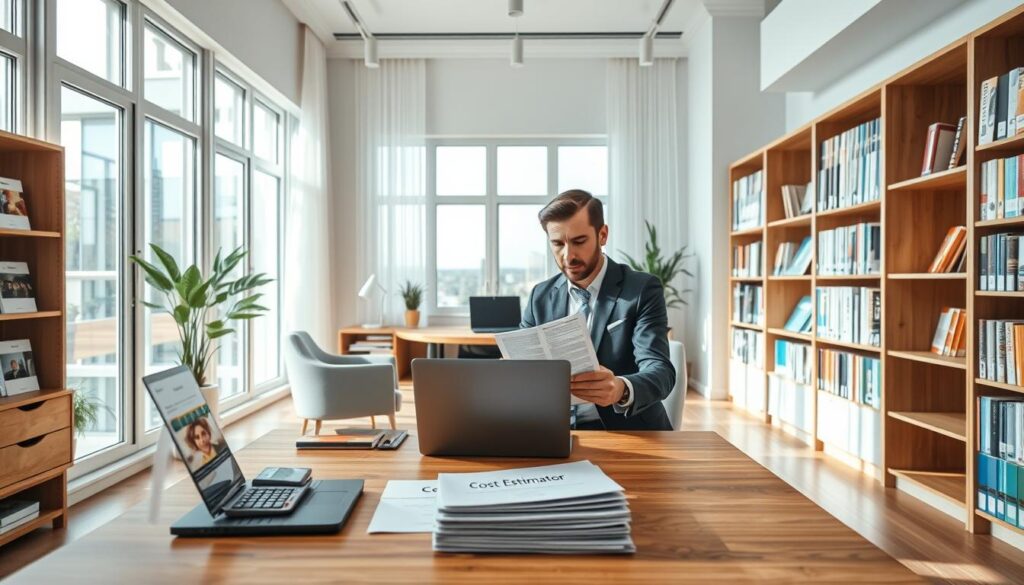
Regional Price Variations Overview
Prices also change based on local market conditions. Places with a lot of demand for painting and not enough contractors tend to have higher prices.
| Region | Average Cost per Square Foot | Average Cost to Paint a Room |
|---|---|---|
| Urban | $2 – $5 | $500 – $1,000 |
| Rural | $1.5 – $3 | $300 – $700 |
Local Market Effects on Pricing
Local market conditions greatly affect painting costs. Things like the local economy, competition among painters, and rules can all change prices.
For instance, places with strict rules on paint disposal and cleanup might cost more. This is because of the extra steps needed to follow these rules.
Seasonal Considerations
The timing of your interior painting project can greatly affect the cost of painting a house interior. Knowing when to plan your project is key to success.
Best Time of Year to Paint
Choosing the right season for painting is crucial. Spring and fall are best because the weather is mild. This ensures the paint dries well and looks great.
Painting during these seasons also means you might get better prices. Contractors are less busy, leading to more competitive offers. So, painting in spring or fall can save you money.
Seasonal Discounts and Offers
Many painters offer seasonal discounts when it’s slow. Painting in winter or late fall can get you a discount. It’s a good time to save.
Always ask about discounts when getting quotes. Some painters have special deals for new customers. This can lower your professional interior painting cost.
Weather Impact on Painting Costs
Interior painting isn’t as weather-dependent as exterior work. But, bad weather can still affect your project. Humidity or cold can slow paint drying and impact the finish.
In areas with extreme weather, prices might be higher. This is because the weather adds extra challenges. Knowing this helps you budget better and plan your project.
By thinking about the season and weather, you can make smart choices. This ensures your painting project goes well and is affordable.
Additional Costs to Keep in Mind
When planning to paint your home’s interior, there are extra costs to think about. These can add up and surprise you if you don’t plan ahead. It’s key to include these costs in your budget to avoid any last-minute expenses.
Supplies and Tools Costs
The cost of supplies and tools can quickly add up. You’ll need paintbrushes, rollers, and extension poles to get the job done. Better tools mean a smoother finish, but they cost more.
Here’s a list of common supplies and their estimated prices:
| Supply | Estimated Cost |
|---|---|
| Paintbrushes (various sizes) | $20-$50 |
| Rollers and extension poles | $30-$70 |
| Paint trays and liners | $10-$30 |
Cost of Hiring Additional Help
If you’re doing a big painting job or don’t want to paint yourself, hiring help can be pricey. You might need to hire pros or get friends and family to help. The cost will depend on how many people you hire and how long it takes.
For example, hiring a pro painter can cost between $40 to $100 an hour. This depends on where you live and their experience.
Cleanup and Disposal Expenses
After painting, you’ll have to clean up and dispose of leftover paint and tools. This includes getting rid of paint, cleaning your tools, and removing tape and covers.
Some places have special days for hazardous waste like paint. Others might need you to take it to a specific place. Disposing of paint can cost between $10 to $50 per can, based on local rules.
Estimating Total Project Costs
To accurately estimate the total cost of painting your home’s interior, it’s crucial to consider all the factors involved. We will guide you through creating a comprehensive budget, anticipating hidden costs, and understanding potential cost overruns.
Creating a Comprehensive Budget
A comprehensive budget for your interior painting project should include the cost of paint, labor (if hiring professionals), and necessary supplies. Using an interior painting cost estimator tool can help you get a preliminary estimate. Consider the cost of painting a house interior based on the size of your home, the number of rooms, and the type of paint you choose.
When budgeting, it’s essential to account for all expenses, including primer, brushes, rollers, and potentially hiring additional help for tasks like furniture moving or surface preparation. A detailed budget helps in avoiding surprises during the project.
Hidden Costs to Anticipate
Several factors can lead to hidden costs in an interior painting project. These may include repairing damaged walls, addressing mold or mildew issues, or dealing with unexpected structural problems. Being aware of these potential issues can help you plan more effectively.
Also, if you’re hiring professionals, their professional interior painting cost may vary based on your home’s condition and the job’s complexity. Always ask for a detailed breakdown of their estimate to understand what’s included.
Cost Overruns: What to Expect
Even with careful planning, cost overruns can occur. Changes in the project’s scope, unforeseen repairs, or delays can all impact the final cost. Understanding that some flexibility is necessary can help manage expectations.
To mitigate cost overruns, we recommend regularly reviewing the project’s progress with your contractor (if hired) and maintaining open communication about any changes or concerns. This proactive approach can help keep your project on track and within budget.
Getting Quotes and Estimates
Getting quotes for painting your home’s interior is key. It might seem tough, but it’s important to find the best deal.
Comparing Multiple Estimates
Comparing different quotes is crucial. It helps you see the average interior house painting cost. You can spot any quotes that stand out as too high or too low.
| Contractor | Price Quote | Services Included |
|---|---|---|
| Contractor A | $2,500 | Painting, primer, surface preparation |
| Contractor B | $3,000 | Painting, primer, surface preparation, furniture moving |
| Contractor C | $2,000 | Painting, surface preparation |
The table shows how prices can differ based on services. Make sure you’re comparing the same things when looking at contractors.
What to Ask Potential Contractors
Don’t just look at the price. Ask about the services and quality too. Here are some questions to ask:
- What is included in your quote?
- What type of paint do you use, and is it eco-friendly?
- Do you provide a warranty for your work?
- Can you provide references or examples of previous work?
These questions help you understand the home interior painting prices. They show you the value you’re getting.
“The key to a successful painting project is not just about the cost; it’s about the quality of work and the materials used.”
Understanding Quote Inclusions
It’s important to know what’s in a quote. Some services might cost extra. Always ask about the painting cost per square foot and any extra charges.
By carefully looking at quotes, you can choose wisely. This ensures your painting project fits your budget and meets your expectations.
Conclusion and Final Thoughts on Painting Costs
Knowing how much it costs to paint a home’s interior is key for homeowners wanting to update their space. By looking at different factors that affect painting costs, you can plan better and stick to your budget.
Key Considerations
When figuring out the cost to paint your home’s interior, think about a few things. The size of your home, the paint type, and if you’ll hire pros are important. An interior painting cost estimator can give you a closer estimate.
Budgeting Tips
To budget well for painting your home’s interior, get quotes from several contractors. Look at the cost of hiring pros and remember to add in extra costs like supplies and cleanup. This way, you can manage your spending and get the results you want.
Knowing what affects painting costs helps you make smart choices. This way, your painting project will be a success, fitting your needs and budget.
